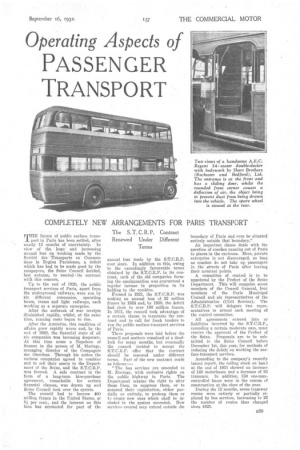Operating Aspects o
Page 65

If you've noticed an error in this article please click here to report it so we can fix it.
PASSENGER TRANSPORT
COMPLETELY NEW ARRANGEMENTS FOR PARIS TRANSPORT
THE future of public surface transport in Paris has been settled, after nearly 12 months of uncertainty. in view of the huge and increasing annual loss on working made by the Societe de S Transports en Commuu dans in Region Parisienne, a deficit which has had to be made good by the ratepayers, the Seine Council decided, last autumn, to rescind.. its contract with this coneern.
Up to the end of 1920, the public transport services of Paris, apart from the underground railways, were run by six different companies, operating buses, trams and light railways, each working as a separate enterprise.
After the outbreak of war receipts diminished rapidly, whilst, at the same time, running costs began to rise.
After the Armistice, this condition ef affairs grew rapidly worse and, by the end of 1920, the financial state of all six companies was becoming desperate. At this time arose a Napoleon of finance in the person of M. Mariage, managing director of the Compagnie des Omnibus. Through his action the various companies agreed to combine and to sell their assets to the Department of the Seine, and the S.T.C.R.P. was formed. A sale contract in the form of a long-term hire-purchase agreement, remarkable for certain financial clauses, was drawn up and Seine Council took over the system.
The council had to borrow 400 million francs in the United States, at per cent., and the interest on this loan has accounted for part of th.? annual loss made by the S.T.C.R.P. ever since. In addition to this, owing to the exceedingly favourable terms obtained by the S.T.C.R.P. in its contract, each of the old companies forming the amalgamation was guaranteed a regular income in proportion to its holding in the combine.
Formed in 1921, the S.T.C.R.P. was making an annual loss of 52 million francs by 1924 and, by 1930, the deficit had risen to over 100 million francs. In 1931, the council took advantage of a certain clause to terminate the contract and to call for fresh tenders to run the public surface-transport services of Paris.
Three proposals were laid before the council and matters remained at a deadlock for many months, but eventually the council decided to accept the S.T.C.R.P. offer that tbe contract should be renewed under different terms. Part of the new contract reads as follows:— "The bus services are conceded to M. Marlage, with exclusive rights on the public highway in Paris. The Department retains the right to alter these lines, to suppress them, or to suspend their exploitation, either partially or entirely, to prolong them or t) create new ones which shall be included in the system conceded. New services created may extend outside the boundary of Paris and even be situated entirely outside that boundary."
An important clause deals with the question of coaches running out of Paris to places in the environs. Here, private enterprise is not discouraged, so long as coaches do not take up passengers in the streets of Paris after leaving their terminal points.
A committee of control is to be appointed by the Prefect of the Seine Department. This will comprise seven members of the Conseil General, four members of the Paris Municipal Council and six representatives of the Administration (Civil Service): The S.T.C.R.P. will delegate two representatives to attend each meeting of the control committee.
All agreements entered into or liabilities incurred by the S.T.C.R.P., exceeding a certain moderate sum, must receive the approval of the Prefect of the Seine. Proposals are to be submitted to the Seine Council before December 1st, this year, for methods of reducing the deficit on working the surface-transport services.
According to the company's recently issued report, the tvlfing stock on han.J at the end of 1981 showed an increase of 143 motorbuses and a decrease of 95 tramcars. In addition, 150 one-mancontrolled buses were in the course cf construction at the close of the year.
During the 12 months, seven tramway routes were entirely or partially replaced by bus services, increasing to 22 the number g routes thus changed since. 1925.












































































































